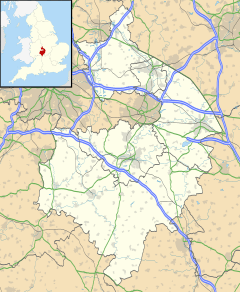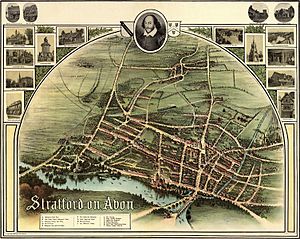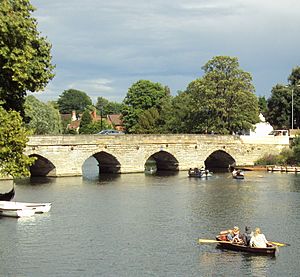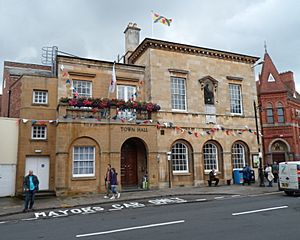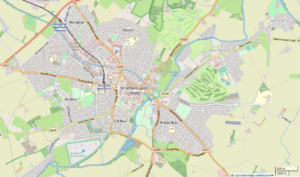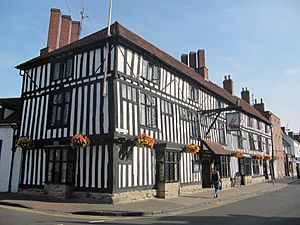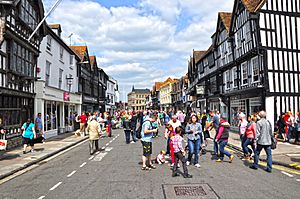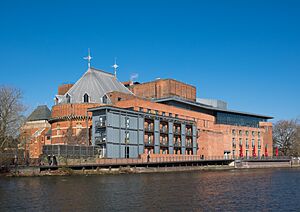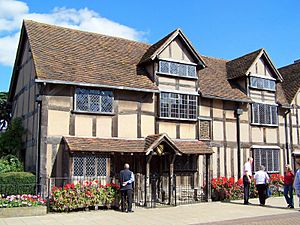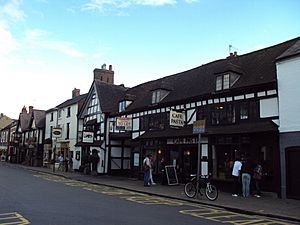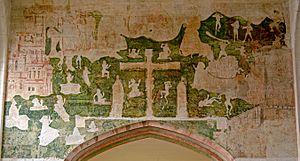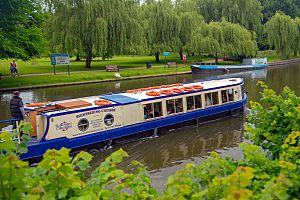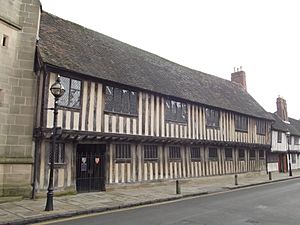Stratford-upon-Avon facts for kids
Quick facts for kids Stratford-upon-Avon |
|
|---|---|
| Town | |
|
Clockwise, from top: Centre of Stratford, from High Street; Shakespeare's Birthplace; Royal Shakespeare Theatre; Holy Trinity Church; and Shakespeare's funerary monument, at Holy Trinity Church |
|
| Population | 30,495 (2021 census) |
| Demonym | Stratfordian |
| OS grid reference | SP1955 |
| Civil parish |
|
| District |
|
| Shire county | |
| Region | |
| Country | England |
| Sovereign state | United Kingdom |
| Post town | STRATFORD-UPON-AVON |
| Postcode district | CV37 |
| Dialling code | 01789 |
| Police | Warwickshire |
| Fire | Warwickshire |
| Ambulance | West Midlands |
| EU Parliament | West Midlands |
| UK Parliament |
|
Stratford-upon-Avon is a famous market town and civil parish in Warwickshire, England. It's often just called Stratford. The town sits on the River Avon, about 91 miles (146 km) north-west of London. It's also 22 miles (35 km) south-east of Birmingham.
Stratford was originally a small village. In 1196, the local lord, John of Coutances, planned to turn it into a town. That same year, King Richard I gave Stratford permission to hold a weekly market. This made it a "market town." This led to more trade and the town grew bigger.
Today, Stratford is a very popular place for tourists. This is because it's the birthplace and burial place of the famous writer William Shakespeare. About 2.7 million people visit the town every year. The Royal Shakespeare Company, a famous theatre group, has its home here at the Royal Shakespeare Theatre.
Contents
- What's in a Name?
- A Look Back in Time
- How Stratford is Governed
- Where is Stratford?
- Weather in Stratford
- Who Lives Here?
- What Drives the Economy?
- Culture and Fun
- Famous Streets
- Other Places to Visit
- Getting Around Stratford
- Learning in Stratford
- Sports and Activities
- Churches in Town
- Famous Faces from Stratford
- Sister Cities
- Freedom of the Town
- See also
What's in a Name?
The name Stratford-upon-Avon comes from old words. Strǣt means 'street' (from the Latin word stratum). Ford means a shallow part of a river that you can walk or drive across. Avon is a Celtic word for river.
The 'street' was actually a Roman road. It connected two other Roman roads. The 'ford' was used for crossing the river since Roman times. Later, the Clopton Bridge was built in this spot.
The name Stratford was first used in 1251–52. It helped tell the difference between the older part of the town and newer areas.
A Look Back in Time
Early Days: Romans and Anglo-Saxons
People lived in the Stratford area during the Roman period. Archaeologists have found remains of a small Roman town nearby. It was used from the 1st to the 5th century AD.
Later, in the 7th century, Anglo-Saxons settled here. It's thought that an Anglo-Saxon monastery was built where Holy Trinity Church stands today. This monastery was probably destroyed by Viking invaders in 1015. The area around Holy Trinity Church is still called Old Town because it was the first settlement.
Growing into a Town
Stratford was a village until the late 12th century. Then, Bishop John of Coutances helped it grow into a town in 1196. He created a new town plan with a grid system. This allowed people to rent land and set up businesses.
King Richard I also gave Stratford a special permission (a charter) in 1196. This allowed a weekly market to be held. These two actions helped Stratford become a market town. In 1996, the town celebrated its 800th anniversary!
As Stratford grew, it became a place for tradesmen and merchants. By 1252, there were about 240 "burgages" (rental properties). Tradesmen formed a group called the Guild of the Holy Cross. This guild helped with business and religious needs. They built a Guild Chapel in the 13th century. They also built a Guildhall and almshouses (homes for poor people) around 1417.
Many of the town's oldest buildings are along the "Historic Spine." This was once the main path from the town centre to the church. It starts at Shakespeare's Birthplace on Henley Street. It goes through High Street, where you can see Elizabethan buildings like Harvard House. It continues along Chapel Street, past Nash's House and New Place. The path ends in the Old Town, where Hall's Croft and the Holy Trinity Church are located.
For a long time, the only way to cross the River Avon was a wooden bridge. This bridge was often hard to cross when the river was high. In 1484, a new stone bridge called Clopton Bridge was built. It was paid for by Hugh Clopton, a rich local man. This new bridge made trade much easier for Stratford.
Tudor Times
During the Tudor period, the local government changed a lot. The Guild of the Holy Cross was closed down in 1547. The people of Stratford then asked the King for permission to form a new Town Council. They received this in 1553. This new council took over the guild's property and duties. It also re-established Stratford's school as the King Edward VI School.
The nearby Cotswolds area was known for sheep farming. Stratford became a key place for processing and selling sheep and wool. This led to industries like tanning (making leather) and Glove making. Malting (processing grain for brewing) was also important.
John Shakespeare, William Shakespeare's father, moved to Stratford in 1551. He became a successful glove maker and businessman. He was also an official on the Town Council. He married Mary Arden around 1557. Their most famous child, William Shakespeare, was born in 1564. He is believed to have been born in the house now known as Shakespeare's Birthplace.
Later Centuries
Stratford was involved in the English Civil War (1642-1651). Because it was at a crossroads, it was important for both sides. The town was mostly controlled by the Parliamentarian army. In 1643, the Market Hall was destroyed when gunpowder stored there blew up. Famous people like Prince Rupert and Oliver Cromwell passed through Stratford during the war.
Even with more trade, Stratford didn't grow much until the late 18th century. Then, new developments like John Payton's project created new streets. In 1769, the actor David Garrick held a big festival called the Shakespeare Jubilee. This event brought many visitors and helped make Stratford a popular tourist spot.
Before roads and railways were common, Stratford was important for canals. The River Avon was made easier to travel on by boats in 1639. This connected Stratford to the River Severn and allowed goods like sugar, wine, and iron to be moved.
Modern Stratford
Between 1793 and 1816, the Stratford-upon-Avon Canal was built. This linked Stratford to Birmingham. By the early 1800s, Stratford was a busy port for trade.
The first railway in the area, the Stratford and Moreton Tramway, opened in 1826. It was a horse-drawn line for goods. Later, steam railways arrived in 1859 and 1860. These railway links helped the modern tourism industry grow.
Stratford didn't become a big industrial city. But some industries, like brewing and making tarpaulins, did grow. The original Shakespeare Memorial Theatre opened in 1879. It was destroyed by fire in 1926. A new theatre, designed by Elisabeth Scott (a woman architect!), opened in 1932.
In 1974, the old town area of Stratford became part of the larger Stratford-on-Avon District. The town now has its own Town Council.
How Stratford is Governed
Stratford-upon-Avon has three levels of local government:
- County-level: Warwickshire County Council handles big things like education and roads.
- District-level: Stratford-on-Avon District Council manages housing, planning, and rubbish collection for Stratford and nearby areas.
- Parish-level: Stratford-upon-Avon Town Council looks after things like crime prevention, parks, and choosing the town's mayor. The Town Council is based at the Town Hall.
Where is Stratford?
Stratford is 22 miles (35 km) south-east of Birmingham. It's near the northern edge of the Cotswolds. The town is about 6 miles (10 km) north-east of the borders with Worcestershire and Gloucestershire.
The River Avon flows through Stratford. Most of the town is on the west side of the river. Because of its location, the town can sometimes experience flooding.
Stratford has several areas that used to be separate villages but are now part of the town. These include Alveston, Shottery, and Tiddington. Other parts of the town are Bishopton, Bridge Town, Clopton, and Old Town.
 |
Redditch, Birmingham | Solihull Henley-in-Arden |
Coventry, Rugby Warwick, Leamington Spa |
 |
| Worcester, Droitwich, Alcester | Southam, Daventry, Northampton | |||
| Evesham, Tewkesbury, Gloucester | Chipping Norton, Witney, Cirencester, Swindon | Banbury, Oxford, Reading, London |
Weather in Stratford
Stratford has a mild climate, like most of the British Isles. This means it rarely gets extremely hot or cold. It gets a moderate amount of sunshine throughout the year. Rain is spread out evenly, with about 615 mm (24 inches) falling each year.
| Climate data for Stratford-upon-Avon, elevation 49 metres (161 feet), 1971–2000 | |||||||||||||
|---|---|---|---|---|---|---|---|---|---|---|---|---|---|
| Month | Jan | Feb | Mar | Apr | May | Jun | Jul | Aug | Sep | Oct | Nov | Dec | Year |
| Mean daily maximum °C (°F) | 6.9 (44.4) |
7.5 (45.5) |
10.2 (50.4) |
12.8 (55.0) |
16.5 (61.7) |
19.4 (66.9) |
22.2 (72.0) |
21.7 (71.1) |
18.5 (65.3) |
14.3 (57.7) |
9.9 (49.8) |
7.7 (45.9) |
14.0 (57.2) |
| Mean daily minimum °C (°F) | 0.7 (33.3) |
0.5 (32.9) |
2.0 (35.6) |
3.2 (37.8) |
5.8 (42.4) |
8.8 (47.8) |
10.9 (51.6) |
10.7 (51.3) |
8.7 (47.7) |
6.0 (42.8) |
2.8 (37.0) |
1.5 (34.7) |
5.2 (41.4) |
| Average precipitation mm (inches) | 55.6 (2.19) |
40.6 (1.60) |
45.6 (1.80) |
46.5 (1.83) |
48.8 (1.92) |
55.3 (2.18) |
44.0 (1.73) |
61.1 (2.41) |
55.0 (2.17) |
56.2 (2.21) |
52.0 (2.05) |
61.4 (2.42) |
622.3 (24.50) |
| Mean monthly sunshine hours | 48.7 | 61.3 | 95.2 | 132.0 | 177.0 | 167.1 | 189.4 | 177.9 | 129.6 | 98.0 | 60.6 | 42.5 | 1,379.2 |
| Source: Met Office | |||||||||||||
Who Lives Here?
In 2021, Stratford had a population of 30,495 people. This is an increase from previous years. The town has been growing with new homes being built.
Most residents in 2021 were White (92.7%). Other groups included Asian (3.3%), Black (0.6%), and Mixed (2.4%). In terms of religion, 58.4% of people identified as Christian. About 38.2% said they had no religion.
What Drives the Economy?
Tourism is a huge part of Stratford's economy. Many people work in hotels, restaurants, and other visitor services. Other jobs in town include boat building, bicycle making, and engineering. There are also jobs in food production, IT, and retail.
Big employers in Stratford include the NFU Mutual Insurance Company and major supermarkets like Tesco and Marks & Spencer. The three Royal Shakespeare Company theatres bring in many visitors and money for the town.
Tourism is Key
Stratford gets between 2.5 million and 3 million visitors every year. This makes tourism the main source of money for the town. People come from all over the world to see Shakespeare's birthplace. The local council works to promote tourism in the area.
Shopping Spots
Besides the town centre shops, there's the Maybird Shopping Park. It's a large shopping centre a short drive from the town. The Rosebird Centre is smaller, with a Waitrose supermarket and other shops. Bell Court Shopping Centre is in the town centre. It has restaurants and various stores.
Culture and Fun
Theatre Life
The first theatre in Stratford was a temporary wooden one built in 1769. Actor David Garrick used it for his Shakespeare Jubilee celebrations. In 1879, the first permanent Shakespeare Memorial Theatre was built. It was very successful but burned down in 1926.
The current Royal Shakespeare Theatre was designed by Elisabeth Scott and opened in 1932. The famous Royal Shakespeare Company (RSC) was formed here in 1961. The RSC also runs two smaller theatres: the Swan Theatre and The Other Place. These theatres were closed for a while for renovations and reopened in 2010 and 2016.
Stratford also has The Bear Pit Theatre and The Attic Theatre. These are smaller, local theatres that put on great shows.
TV and Movies
The town is the setting for the 2018 BBC detective show Shakespeare & Hathaway: Private Investigators.
Music Scene
Stratford ArtsHouse is home to the Orchestra of the Swan. This is a professional orchestra that performs concerts with international musicians. There are also other places in town that host live music events.
Museums and Shakespeare's Homes
Tudor World is a museum that shows what life was like when Shakespeare lived. It's in an old Tudor building. The Mechanical Art and Design (MAD) museum on Henley Street has cool, moving machines made by kinetic artists.
The Shakespeare Birthplace Trust looks after five houses connected to William Shakespeare:
- Hall's Croft: Home of Shakespeare's daughter, Susanna.
- Nash's House: Next to New Place, which Shakespeare owned and where he died.
- Anne Hathaway's Cottage: The home of Shakespeare's wife's family.
- Mary Arden's House: The family home of Shakespeare's mother.
- King Edward VI School: Where Shakespeare is thought to have studied. You can now visit the schoolroom!
Books and Festivals
Stratford has a library on Henley Street. Since 2008, the town has hosted the Stratford-upon-Avon Literary Festival. This festival has talks from famous authors and workshops. It's become one of the most important literary festivals in the country.
Shakespeare's Birthday
Every year, Stratford celebrates Shakespeare's birthday. The celebration happens on the weekend closest to April 26th (his christening date). It includes music, plays, and a parade through the town. In 2016, there were special events to mark 400 years since Shakespeare's death.
Local Hangouts
The Garrick Inn is said to be the oldest pub in Stratford. The Dirty Duck, near the river, is popular with actors from the RSC theatres. The town also hosts a yearly cider and beer festival.
Local News
Local news and TV come from BBC West Midlands and ITV Central. For radio, you can listen to BBC CWR, Capital Mid-Counties, Hits Radio Coventry & Warwickshire, and Welcombe Radio. The main local newspapers are the Stratford Observer and Stratford Herald.
Famous Streets
Church Street
Church Street is an extension of Chapel Street and High Street. It has the old front of King Edward VI School, where Shakespeare is believed to have gone to school.
Henley Street
Henley Street is one of the town's oldest streets. John Shakespeare's large half-timbered house, bought in 1556, is where his son William was born in 1564. This property stayed in Shakespeare's family until 1670. The main house became an inn called the Maidenhead.
Today, Henley Street is a busy area for tourists and shopping. You'll find many outdoor cafes and street performers.
Scholars Lane
Scholars Lane was part of the town's original grid plan from 1196. It was first called Tinkers Lane around 1330. This is where tinkers (people who mended pots and pans) would gather on market days.
Sheep Street
Sheep Street runs from Ely Street to the Waterside. In the 16th century, it was a residential area. Some buildings here date back to 1480. As its name suggests, Sheep Street was where sheep were bought and sold until the late 1800s. Today, it's known as the town's restaurant hub.
The Shrieves House is one of the oldest homes still lived in. It's said that William Shakespeare based his character Sir John Falstaff on someone who lived here. Oliver Cromwell is also thought to have stayed here in 1651. Behind The Shrieves House is the "Tudor World" museum.
Waterside and Southern Lane
This area runs along the River Avon. It's near the Waterside Theatre and the Royal Shakespeare Theatre. The Bancroft Gardens and river area are popular for picnics and watching people. The gardens also have the Gower Monument, a statue of William Shakespeare and some of his characters.
In summer, the River Avon is busy with rowing boats and river cruises. The Stratford-upon-Avon Canal is filled with colourful narrowboats. You can often see jugglers and magicians entertaining people on the lawns. The Swan Fountain, unveiled by Queen Elizabeth II in 1996, is also here. It celebrates Stratford being a market town since 1196.
Other Places to Visit
Harvard House is a historic building on High Street. Other attractions include the Stratford Butterfly Farm, located across the river. The Stratford Armouries is a museum about weapons and armour. Each year, Stratford hosts one of the largest "mop fairs" (a type of traditional hiring fair).
The Guild Chapel, at Church Street and Chapel Lane, has a long connection to Shakespeare's family. You can see beautiful paintings from the early 1500s that were once hidden.
Getting Around Stratford
By Road
Stratford is 22 miles (35 km) from Birmingham. You can easily reach it from junction 15 of the M40 motorway. The A46 road connects Stratford to the M40 and other towns like Warwick and Coventry.
By Bus
Bus services are mainly provided by Stagecoach and Diamond West Midlands. Buses connect Stratford to nearby places like Banbury, Coventry, and Leamington.
By Train
Stratford has two railway stations: Stratford-upon-Avon (the main town centre station) and Stratford-upon-Avon Parkway (on the north-western edge with parking).
Trains from these stations go to Birmingham and Worcester. Some direct trains also go to London Marylebone. The train service to London has been criticized for not having enough direct trains for a major tourist spot.
By Water
Several companies offer boat tours along the River Avon and the Stratford-upon-Avon Canal. The town is where the canal meets the river. The manually-powered Stratford-upon-Avon chain ferry, opened in 1937, crosses the river near the Royal Shakespeare Theatre.
By Bike
Stratford has many cycle paths. The Stratford greenway is a 5-mile (8 km) path without cars. It used to be a railway line. It's now part of the Sustrans National Cycle Network. You can rent bikes at the start of the Greenway.
By Air
Birmingham Airport is 18 miles (29 km) north-west of Stratford. It has flights to many places in the UK and around the world.
Learning in Stratford
Stratford has several places for studying Shakespeare. The Shakespeare Birthplace Trust has many books and documents about the famous writer. The Shakespeare Institute is also here.
King Edward VI School is a grammar school that Shakespeare is thought to have attended. It's now for boys, but girls can join in the final two years. There's also an all-girls grammar school, Stratford-upon-Avon Grammar School for Girls, in Shottery.
Stratford-upon-Avon School is a non-selective secondary school. The town also has many primary schools and Stratford-upon-Avon College for further education.
Sports and Activities
Stratford-upon-Avon Rugby Club has teams for different age groups. The Stratford-upon-Avon Cricket Club Ground is by the River Avon. It has hosted important cricket matches.
The town has a 5k parkrun event every Saturday morning. There's also a junior parkrun for kids aged 4 to 14 on Sundays. Stratford Racecourse holds horse racing events 18 times a year. It's known as one of the UK's top small racecourses.
Churches in Town
Famous Faces from Stratford
Many famous actors have lived or stayed in Stratford because of the Royal Shakespeare Company. These include:
- William Shakespeare (1564–1616), the famous English writer.
- David Bradley, known for the Harry Potter films.
- Craig Charles (1964–), actor and DJ from Red Dwarf.
- Sarah Douglas (1952–), actress born and raised here.
- Simon Pegg, actor, studied at Stratford-upon-Avon College.
- Patrick Robinson (1963–), actor from Casualty.
Other notable people connected to Stratford include:
- Arthur C. Clarke, author of 2001: A Space Odyssey, who served in the RAF here.
- Lord Digby Jones, a businessman who lives near Stratford.
- David Domoney (1963–), a gardener and TV host.
- Dion Dublin, a famous English footballer.
- Gordon Ramsay, the well-known celebrity chef, moved to Stratford when he was nine.
- Adrian Newey, a famous Formula 1 car designer.
- Andrew Pozzi (1992–), an Olympic hurdler born in Stratford.
- Quentin Willson (1957–), a motoring expert and journalist.
Sister Cities
Stratford-upon-Avon has several "twin towns" or "sister cities" around the world. These are places that share a friendly connection.
| Town | Country |
|---|---|
| Stratford, Victoria | Australia |
| Stratford, Ontario | Canada |
| Stratford, Prince Edward Island | Canada |
| Stratford, Taranaki | New Zealand |
| Stratford, Connecticut | United States |
Freedom of the Town
Some special people have been given the "Freedom of the Town" of Stratford-upon-Avon. This is a great honour!
- Sir Kenneth Branagh: April 22, 2022.
- Dame Judi Dench: April 22, 2022.
See also
 In Spanish: Stratford-upon-Avon para niños
In Spanish: Stratford-upon-Avon para niños







